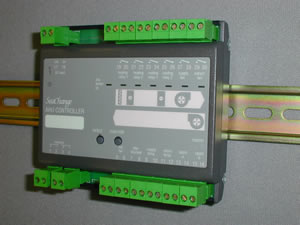Feature
|
Configuration Tables |
Data Sheet |
Wiring |
History |
Feature Notes |
Datasheet |
Air Handing Unit Controller
|
|
Latest released version is 4c2Document last updated 03/11/2003 |
AHU / DIN / FRE / .../.../... |
Main FeaturesControls Supply & Extract Fans, Heating and Cooling BatteriesMore complex Air Handling Units controlled by adding modulesAHU may feed single or multiple zonesConstant Supply, fixed or user adjustable setpointDemand signals fed to Main Plant automatically |
 |
FANF |
Fan Failure (which would need a “fan running” status signal wired to the appropriate input) |
FLTF |
Filter Blocked (which would need a differential pressure switch installed
across the filter). |
ALRM = 0 |
Ignore alarms (inputs could be used for monitoring status of any volt-free contact) |
ALRM = 1 |
Report alarms FANF and FLTF, no control action |
ALRM = 2 |
Report alarms, shut down all outputs on receipt of STOP alarm |
ALRM = 3 |
Report alarms, shut down all outputs on STOP alarm or FANF alarm |
FANF |
Alarm if generated from a Fan Changeover Module registered to the AHU (if this feature is not required, the Changeover Module’s ALRM parameter may be set to generate no alarms) |
FREZ |
Danger of Freezing, which is generated when the Supply Air Temperature drops below a limit set on parameter CUTS (default 4 degC). If this value is set to zero, this feature is disabled |
SPLF |
Supply Temperature Failed which is generated when the Supply Sensor reading is invalid (not used if SPTY set to 6 or 7, Return-only control) |
OUTF |
Outside Temperature Fail, which is generated when the AHU Controller is not receiving a valid Outside Temperature (either locally connected or via the network from another module).This alarm does not cause the AHU to shut down |
Input 13-14 |
VFC input or potentiometer |
INMD = 1 |
Disabling AHU from an External Contact |
INMD = 2 |
Enabling AHU from an External Contact |
|
Enabling AHU from an External Contact |
INMD = 1, 2 or 3 |
External Setpoint Trim Potentiometer |
INMD = 1 |
Setpoint Trim with external Disable Contact |
INMD = 2 or 3 |
Setpoint Trim with external Enable Contact |
Submodule Type |
Max |
Preheater Submodule |
1 |
Humidity Submodule |
1 |
T+Rh Networked Sensors |
3 |
Submodule Type |
Max |
Damper Submodule |
1 |
or |
|
Heat recovery Submodule |
1 |
Submodule Type |
Max |
Fan Changeover Submodules |
2 |
or |
|
Static Pressure Submodule |
2 |
Submodule Type |
Cascade Submodule |
or |
Actuator Submodule |
or |
Dessicant Wheel Controller |
Option |
Heater Battery |
Cooling Battery |
/ WW / |
Raise / Lower Valve |
Raise / Lower Valve |
/ WE / |
Raise / Lower Valve |
2 Stage Electric |
/ EW / |
2 Stage Electric |
Raise / Lower Valve |
/ EE / |
2 Stage Electric |
2 Stage Electric |
Option |
Housekeeping |
/ SH / |
With System Housekeeping |
/ NH / |
With No System Housekeeping |
Option |
Variant |
/ 001 |
Standard |